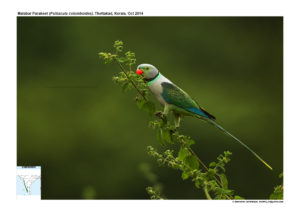
Malabar Parakeet Psittacula columboides
Etymology:
- Psittacula : Latin word derived from psittacus – Parrot
- Columboides : Refers to soft, pastel-shaded blue and grey plumage derived from Charadrius Columbinus – Greater Sand plover ; Greek word oides- Similar
Vernacular Names:Hindi: Madan-gourtota, Mal: Nilatatha, Kan: Neeligini, Mar: Malabar Popat, Nilya Pankhacha Popat
Distribution in India: Resident of Western Ghats in India.
Description: Size of 36–38 cm. The upper mandible is red with yellowish tip, lower is dull brownish. The area from bill to around eye is bluish green and rest of head is warm greyish, with complete black collar that is bordered turquoise below, shading immediately into grey of upper body. The wing-coverts are green edged buff, outer wing-coverts and primaries are deep blue; belly and thighs are light green, rump is light turquoise, tail is deep blue centrally and green laterally, marginally tipped in yellow. The female lacks turquoise in neck-ring, with mantle and breast pale green and black bill. The immature replaces all grey with green.
Habitat: It is found in tropical evergreen and moist deciduous forest, secondary growth, abandoned plantations, and adjacent cultivated clearings. It is found from lowlands to 1600 m.
Food habits: It eats grain, seeds and fruits, buds, petals and nectar. They are a crop pest on Sorghum, other cereals and orchard fruit.
Breeding habits: They breed in Dec–Mar. The nest is in a hole in tree.They lay a clutch of 4–5 eggs. The incubation period is 23 days and incubation done by both sexes, but mostly by female. The female tends young except at end of nestling period, when male does so. The nestling period is 32 days.